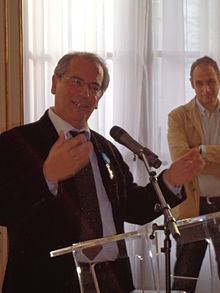Nationality French, Greek Residence France | Name Stavros Katsanevas Institutions IN2P3/CNRS | |
 | ||
Known for Supersymmetry / Astroparticle Physics Notable awards Chevalier de l’Ordre National du Merite (2011), an Order of State awarded by the President of the French Republic Education National and Kapodistrian University of Athens, University of Paris-Sud | ||
Stavros katsanevas virgo e la caccia alle onde gravitazionali
Stavros Katsanevas is professor (Exceptional Class) at the Université Paris VII Denis Diderot, director of the AstroParticle and Cosmology (APC) laboratory and chairman of the Astroparticle Physics European Consortium (APPEC). In 2000, he received for his work on supersymmetry the Physics Prize from the Academy of Athens. In 2011, he was awarded the Ordre National du Merite.
Contents
- Stavros katsanevas virgo e la caccia alle onde gravitazionali
- Katsanevas S Challenges in Astroparticle Physics the APPEC roadmap
- Education and work
- Research interests
- References
Katsanevas S. - Challenges in Astroparticle Physics, the APPEC roadmap
Education and work
Katsanevas was born in Athens, Greece, where he did his undergraduate studies in physics at the University of Athens. He obtained a doctorate "of 3rd cycle" from University of Paris XI and a PhD from the University of Athens, where he was later a lecturer and an associate professor (1982–1996). He has spent three years as a postdoc at the Fermi National Laboratory. He also worked at CERN, as a CERN Fellow, CERN Associate Scientist and as CERN Corresponding fellow. He then moved as a professor to France to the Université de Lyon I Claude Bernard. In 2002, he became Deputy Scientific Director of IN2P3/CNRS for the field of Neutrino and Astroparticle Physics (until 2012), transferring at the same time to the Université Paris VII Denis Diderot, where he is now Professor Exceptional Class.
Since 2000, Katsanevas held the following positions:
He has also been a member of the following committees:
